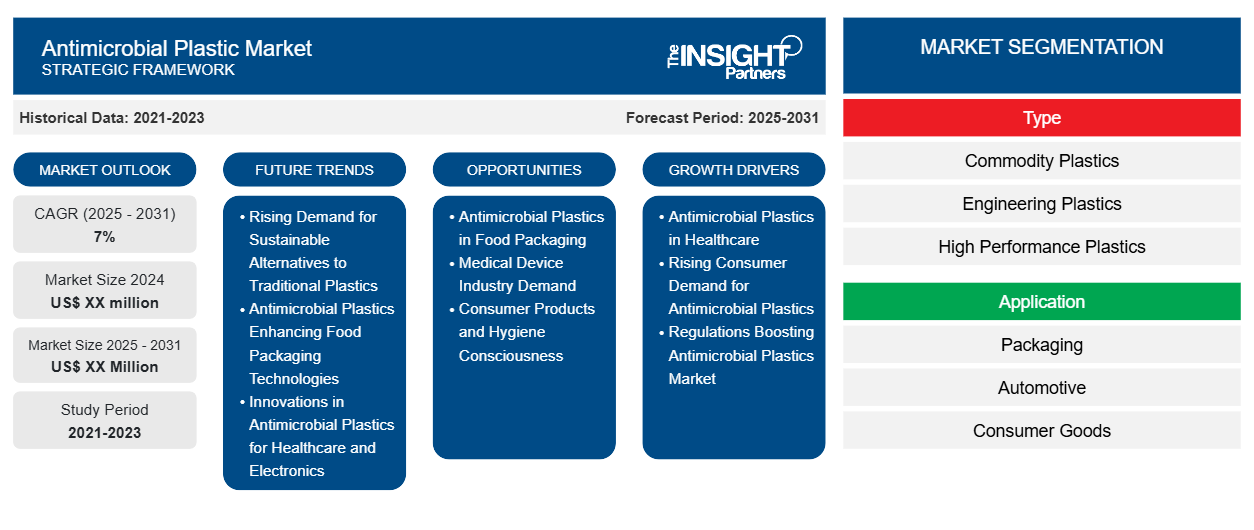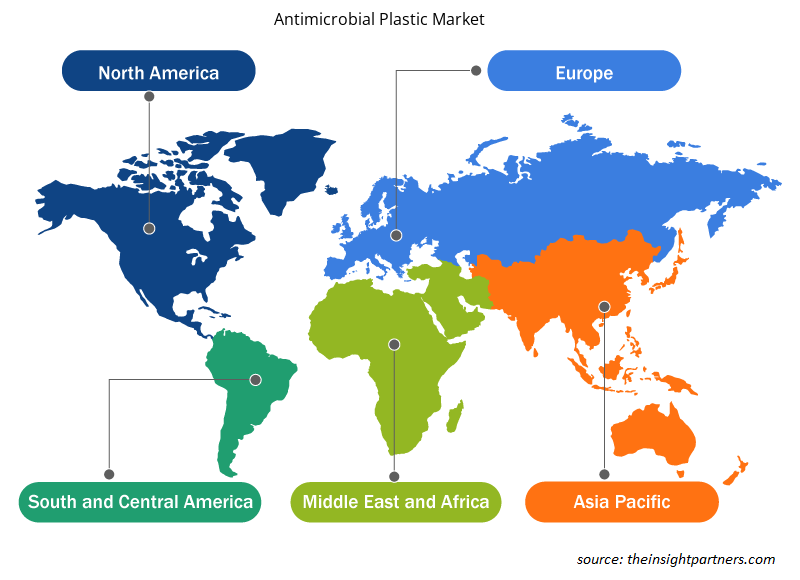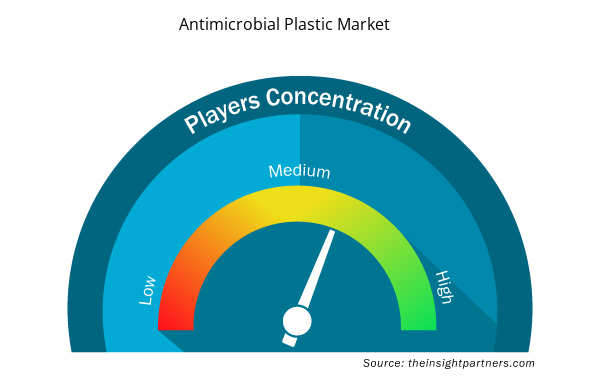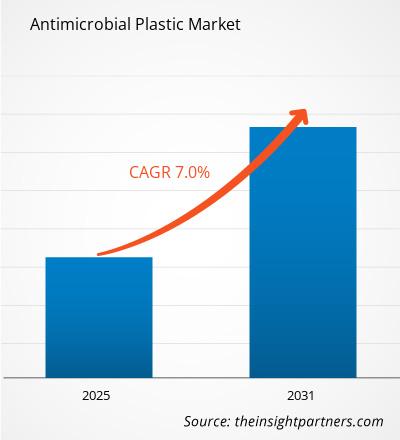Si prevede che il mercato della plastica antimicrobica registrerà un CAGR del 7% dal 2025 al 2031, con una dimensione di mercato in espansione da XX milioni di dollari nel 2024 a XX milioni di dollari entro il 2031.
Il report è segmentato per tipo (materie plastiche di base, materie plastiche ingegneristiche, materie plastiche ad alte prestazioni, altri). L'analisi globale è ulteriormente suddivisa a livello regionale e nei principali paesi. Il report presenta inoltre analisi basate sull'applicazione (imballaggio, automotive, beni di consumo, medicina e sanità, edilizia e costruzioni, altri). L'analisi globale è ulteriormente suddivisa a livello regionale e nei principali paesi. Le dimensioni del mercato e le previsioni a livello globale, regionale e nazionale per tutti i principali segmenti di mercato sono coperte nell'ambito. Il report offre il valore in USD per l'analisi e i segmenti di cui sopra. Il report fornisce statistiche chiave sullo stato di mercato dei principali attori del mercato e offre tendenze e opportunità di mercato.
Scopo del rapporto
Il report Antimicrobial Plastic Market di The Insight Partners mira a descrivere il panorama attuale e la crescita futura, i principali fattori trainanti, le sfide e le opportunità. Ciò fornirà spunti a vari stakeholder aziendali, come:
- Fornitori/produttori di tecnologia: per comprendere le dinamiche di mercato in evoluzione e conoscere le potenziali opportunità di crescita, consentendo loro di prendere decisioni strategiche informate.
- Investitori: condurre un'analisi completa delle tendenze relative al tasso di crescita del mercato, alle proiezioni finanziarie del mercato e alle opportunità esistenti lungo la catena del valore.
- Enti di regolamentazione: regolamentano le politiche e le attività di controllo sul mercato allo scopo di ridurre al minimo gli abusi, preservare la fiducia degli investitori e sostenere l'integrità e la stabilità del mercato.
Segmentazione del mercato della plastica antimicrobica
Tipo
- Materie plastiche di base
- Materie plastiche ingegneristiche
- Plastica ad alte prestazioni
- Altri
Applicazione
- Confezione
- Automobilistico
- Beni di consumo
- Medicina e assistenza sanitaria
- Edilizia e costruzione
- Altri
Personalizza questo report in base alle tue esigenze
Riceverai la personalizzazione gratuita di qualsiasi report, comprese parti di questo report, o analisi a livello nazionale, pacchetto dati Excel, oltre a usufruire di grandi offerte e sconti per start-up e università
Mercato della plastica antimicrobica: approfondimenti strategici

- Scopri le principali tendenze di mercato in questo rapporto.Questo campione GRATUITO includerà analisi di dati che spaziano dalle tendenze di mercato alle stime e alle previsioni.
Fattori trainanti della crescita del mercato della plastica antimicrobica
- Plastiche antimicrobiche nell'assistenza sanitaria: le plastiche antimicrobiche trovano una nicchia nel settore sanitario grazie alle loro proprietà di inibire la crescita batterica e fungina. La proliferazione della domanda e dell'offerta di dispositivi medici più sicuri, più grandi e più sopportabili, controllati dalle infezioni ha portato alla produzione di prodotti in plastica per l'assistenza sanitaria, come strumenti chirurgici, cateteri e tubi per flebo, con additivi antimicrobici. Ciò è dovuto anche alla necessità di prodotti sterilizzati, il che migliora anche l'assistenza sanitaria dei pazienti.
- Crescente domanda dei consumatori di plastiche antimicrobiche: con una maggiore consapevolezza dell'aspetto della pulizia e della necessità di proteggersi dai virus, le plastiche antimicrobiche vengono utilizzate in molti prodotti di consumo. L'industria automobilistica sta utilizzando e includendo plastiche antimicrobiche in articoli come smartphone, utensili da cucina, articoli per la cura della persona, parti di automobili e molti altri prodotti per migliorarli e di conseguenza guarire ed espandere il mercato.
- Regolamenti che potenziano il mercato delle plastiche antimicrobiche: i governi e gli enti che esercitano il controllo includono i requisiti che le plastiche antimicrobiche devono essere utilizzate nei sistemi di trasporto pubblico, negli ospedali e negli istituti scolastici, tra gli altri luoghi, al fine di limitare la diffusione delle malattie. Inoltre, i regolamenti volti a incoraggiare la pulizia delle superfici pubbliche stanno aumentando il mercato delle plastiche antimicrobiche che sono utilizzate principalmente in luoghi con frequente contatto umano come maniglie delle porte, corrimano e panchine.
Tendenze future del mercato della plastica antimicrobica
- Crescente domanda di alternative sostenibili alle plastiche tradizionali: c'è una ricerca costante di materie prime che possano sostituire le plastiche tradizionali con un focus sulla sostenibilità. Nasce dal desiderio di fornire ai consumatori e alle industrie che trovano discutibile l'uso eccessivo di plastiche ma vogliono mantenere i vantaggi di queste plastiche negli imballaggi, nell'assistenza sanitaria, nei prodotti di consumo e così via, le loro caratteristiche antimicrobiche.
- Plastiche antimicrobiche che migliorano le tecnologie di confezionamento alimentare: le plastiche antimicrobiche emergeranno come una componente importante della tecnologia di confezionamento alimentare. Si prevede che aumenteranno le applicazioni di imballaggi intelligenti che integrano in modo ottimale imballaggi passivi e attivi per mantenere la freschezza del prodotto per uno spazio di scaffale prolungato senza crescita microbica. Questi casi conterranno gadget che consentiranno di tracciare l'integrità e la qualità del contenuto, rendendo così le plastiche antimicrobiche una componente importante nelle tecnologie di sicurezza e conservazione alimentare del futuro.
- Innovazioni nelle plastiche antimicrobiche per l'assistenza sanitaria e l'elettronica: l'impulso verso la creazione di polimeri di successo che contengono attività antibatterica nei materiali di consumo sarà più ovvio ed evidente nel fenomeno degli apparati medici e dell'elettronica domestica. Nuove innovazioni nelle formulazioni di plastica che offrono una maggiore durata, resistenza al calore e alle sostanze chimiche ed efficaci proprietà antimicrobiche guideranno l'espansione del mercato. Molto centrale, come senza dubbio la necessità futura affermerà, sarà la produzione di plastiche antimicrobiche da utilizzare nelle superfici di prodotti come smartphone, tastiere di computer e altri gadget elettronici che richiedono il contatto umano.
Opportunità di mercato della plastica antimicrobica
- Plastiche antimicrobiche negli imballaggi alimentari: la tendenza alla sicurezza e all'igiene alimentare spinge all'uso di plastiche antimicrobiche negli imballaggi alimentari. Gli imballaggi che inibiscono la crescita microbica aiutano a mantenere la qualità e la sicurezza dei prodotti di consumo, in particolare quelli deperibili. Ciò è particolarmente vero nel caso dei mercati di consegna di cibo online, in cui l'imballaggio alimentare è fondamentale per sostenere la qualità del cibo e ridurre al minimo i rischi di contaminazione durante il trasporto.
- Domanda del settore dei dispositivi medici: ci sarà un aumento nell'uso di plastiche antimicrobiche nel settore dei dispositivi medici, in particolare per quei componenti che sono accessibili e ad alto rischio di infezione come sacche per il sangue, siringhe, apparecchiature diagnostiche e molti altri. Ci sarà un aumento nella domanda di plastiche antimicrobiche di grado medico man mano che più ospedali, cliniche e strutture sanitarie domiciliari implementeranno con successo misure di controllo delle infezioni.
- Prodotti di consumo e consapevolezza dell'igiene: grazie alla crescente consapevolezza dell'igiene tra i consumatori, le plastiche antimicrobiche saranno utilizzate in vari prodotti comuni come telefoni cellulari e computer insieme alle loro periferiche. C'è un'opportunità per i produttori di distinguersi nel mercato competitivo prendendo di mira i consumatori attenti alla salute e all'igiene, soprattutto ora che le persone stanno uscendo dalla pandemia, grazie alla disponibilità di dispositivi con superfici antimicrobiche.
Approfondimenti regionali sul mercato della plastica antimicrobica
Le tendenze regionali e i fattori che influenzano il mercato della plastica antimicrobica durante il periodo di previsione sono stati ampiamente spiegati dagli analisti di Insight Partners. Questa sezione discute anche i segmenti e la geografia del mercato della plastica antimicrobica in Nord America, Europa, Asia Pacifico, Medio Oriente e Africa e America meridionale e centrale.

- Ottieni i dati specifici regionali per il mercato della plastica antimicrobica
Ambito del rapporto sul mercato della plastica antimicrobica
| Attributo del report | Dettagli |
|---|---|
| Dimensioni del mercato nel 2024 | XX milioni di dollari USA |
| Dimensioni del mercato entro il 2031 | XX milioni di dollari USA |
| CAGR globale (2025 - 2031) | 7% |
| Dati storici | 2021-2023 |
| Periodo di previsione | 2025-2031 |
| Segmenti coperti | Per tipo
|
| Regioni e Paesi coperti | America del Nord
|
| Leader di mercato e profili aziendali chiave |
|
Densità degli attori del mercato della plastica antimicrobica: comprendere il suo impatto sulle dinamiche aziendali
Il mercato del mercato della plastica antimicrobica sta crescendo rapidamente, spinto dalla crescente domanda degli utenti finali dovuta a fattori quali l'evoluzione delle preferenze dei consumatori, i progressi tecnologici e una maggiore consapevolezza dei benefici del prodotto. Con l'aumento della domanda, le aziende stanno ampliando le loro offerte, innovando per soddisfare le esigenze dei consumatori e capitalizzando sulle tendenze emergenti, il che alimenta ulteriormente la crescita del mercato.
La densità degli operatori di mercato si riferisce alla distribuzione di aziende o società che operano in un particolare mercato o settore. Indica quanti concorrenti (operatori di mercato) sono presenti in un dato spazio di mercato in relazione alle sue dimensioni o al valore di mercato totale.
Le principali aziende che operano nel mercato della plastica antimicrobica sono:
- Società per azioni BASF SE
- Bayer Scienza dei Materiali AG
- Biocote limitata
- Clariant Italia S.p.A.
- Dupont De Nemours Inc.
Disclaimer : le aziende elencate sopra non sono classificate secondo un ordine particolare.

- Ottieni una panoramica dei principali attori del mercato della plastica antimicrobica
Punti chiave di vendita
- Copertura completa: il rapporto affronta in modo completo l'analisi di prodotti, servizi, tipologie e utenti finali del mercato della plastica antimicrobica, fornendo una panoramica olistica.
- Analisi degli esperti: il rapporto è compilato sulla base della conoscenza approfondita di esperti e analisti del settore.
- Informazioni aggiornate: il rapporto garantisce la pertinenza aziendale grazie alla copertura di informazioni recenti e tendenze nei dati.
- Opzioni di personalizzazione: questo report può essere personalizzato per soddisfare le esigenze specifiche del cliente e adattarsi in modo appropriato alle strategie aziendali.
Il rapporto di ricerca sul mercato della plastica antimicrobica può quindi aiutare a guidare il percorso di decodifica e comprensione dello scenario del settore e delle prospettive di crescita. Sebbene possano esserci alcune preoccupazioni valide, i vantaggi complessivi di questo rapporto tendono a superare gli svantaggi.
- Analisi storica (2 anni), anno base, previsione (7 anni) con CAGR
- Analisi PEST e SWOT
- Valore/volume delle dimensioni del mercato - Globale, regionale, nazionale
- Industria e panorama competitivo
- Set di dati Excel



Report Coverage
Revenue forecast, Company Analysis, Industry landscape, Growth factors, and Trends

Segment Covered
This text is related
to segments covered.

Regional Scope
North America, Europe, Asia Pacific, Middle East & Africa, South & Central America

Country Scope
This text is related
to country scope.
Domande frequenti
Use in sustainable and biodegradable plastic products is expected to be the key market trends
Based on type, the engineered plastics segment is expected to witness the fastest growth during the forecast period
Based on geography, Asia Pacific held the largest share of the antimicrobial plastic market due to the growing healthcare industry across the region, coupled with continuous growth and development
Expansion in healthcare applications is driving the market growth
BASF SE
; Microban International
; DSM
; PolyOne Corporation
; SABIC
; Clariant International Ltd.
; Momentive Performance Materials
; Hexpol TPE
; U.S. Antimony Corporation
; Eastman Chemical Company
; Ticona
; LyondellBasell
; SABIC Innovative Plastics
; Innovia Films
; Allnex
The Antimicrobial Plastic Market is estimated to witness a CAGR of 7% from 2023 to 2031
Trends and growth analysis reports related to Chemicals and Materials : READ MORE..
The List of Companies
- BASF SE Corporation
- Bayer Material Science AG
- Biocote Limited
- Clariant AG
- Dupont De Nemours Inc.
- King Plastic Corporation
- Lonza Group AG
- Microban International Ltd.
- PARX Plastics N.V.
- Polyone Corporation
- Sanitized AG
- Milliken Chemical
- RTP Company
- Compounding Solutions LLC
- Ray Products Company Inc.
- Covestro AG
- Steritouch
- Doeflex Vitapol
- Ticona Engineering Polymers
- Dow
The Insight Partners performs research in 4 major stages: Data Collection & Secondary Research, Primary Research, Data Analysis and Data Triangulation & Final Review.
- Data Collection and Secondary Research:
As a market research and consulting firm operating from a decade, we have published and advised several client across the globe. First step for any study will start with an assessment of currently available data and insights from existing reports. Further, historical and current market information is collected from Investor Presentations, Annual Reports, SEC Filings, etc., and other information related to company’s performance and market positioning are gathered from Paid Databases (Factiva, Hoovers, and Reuters) and various other publications available in public domain.
Several associations trade associates, technical forums, institutes, societies and organization are accessed to gain technical as well as market related insights through their publications such as research papers, blogs and press releases related to the studies are referred to get cues about the market. Further, white papers, journals, magazines, and other news articles published in last 3 years are scrutinized and analyzed to understand the current market trends.
- Primary Research:
The primarily interview analysis comprise of data obtained from industry participants interview and answers to survey questions gathered by in-house primary team.
For primary research, interviews are conducted with industry experts/CEOs/Marketing Managers/VPs/Subject Matter Experts from both demand and supply side to get a 360-degree view of the market. The primary team conducts several interviews based on the complexity of the markets to understand the various market trends and dynamics which makes research more credible and precise.
A typical research interview fulfils the following functions:
- Provides first-hand information on the market size, market trends, growth trends, competitive landscape, and outlook
- Validates and strengthens in-house secondary research findings
- Develops the analysis team’s expertise and market understanding
Primary research involves email interactions and telephone interviews for each market, category, segment, and sub-segment across geographies. The participants who typically take part in such a process include, but are not limited to:
- Industry participants: VPs, business development managers, market intelligence managers and national sales managers
- Outside experts: Valuation experts, research analysts and key opinion leaders specializing in the electronics and semiconductor industry.
Below is the breakup of our primary respondents by company, designation, and region:

Once we receive the confirmation from primary research sources or primary respondents, we finalize the base year market estimation and forecast the data as per the macroeconomic and microeconomic factors assessed during data collection.
- Data Analysis:
Once data is validated through both secondary as well as primary respondents, we finalize the market estimations by hypothesis formulation and factor analysis at regional and country level.
- Macro-Economic Factor Analysis:
We analyse macroeconomic indicators such the gross domestic product (GDP), increase in the demand for goods and services across industries, technological advancement, regional economic growth, governmental policies, the influence of COVID-19, PEST analysis, and other aspects. This analysis aids in setting benchmarks for various nations/regions and approximating market splits. Additionally, the general trend of the aforementioned components aid in determining the market's development possibilities.
- Country Level Data:
Various factors that are especially aligned to the country are taken into account to determine the market size for a certain area and country, including the presence of vendors, such as headquarters and offices, the country's GDP, demand patterns, and industry growth. To comprehend the market dynamics for the nation, a number of growth variables, inhibitors, application areas, and current market trends are researched. The aforementioned elements aid in determining the country's overall market's growth potential.
- Company Profile:
The “Table of Contents” is formulated by listing and analyzing more than 25 - 30 companies operating in the market ecosystem across geographies. However, we profile only 10 companies as a standard practice in our syndicate reports. These 10 companies comprise leading, emerging, and regional players. Nonetheless, our analysis is not restricted to the 10 listed companies, we also analyze other companies present in the market to develop a holistic view and understand the prevailing trends. The “Company Profiles” section in the report covers key facts, business description, products & services, financial information, SWOT analysis, and key developments. The financial information presented is extracted from the annual reports and official documents of the publicly listed companies. Upon collecting the information for the sections of respective companies, we verify them via various primary sources and then compile the data in respective company profiles. The company level information helps us in deriving the base number as well as in forecasting the market size.
- Developing Base Number:
Aggregation of sales statistics (2020-2022) and macro-economic factor, and other secondary and primary research insights are utilized to arrive at base number and related market shares for 2022. The data gaps are identified in this step and relevant market data is analyzed, collected from paid primary interviews or databases. On finalizing the base year market size, forecasts are developed on the basis of macro-economic, industry and market growth factors and company level analysis.
- Data Triangulation and Final Review:
The market findings and base year market size calculations are validated from supply as well as demand side. Demand side validations are based on macro-economic factor analysis and benchmarks for respective regions and countries. In case of supply side validations, revenues of major companies are estimated (in case not available) based on industry benchmark, approximate number of employees, product portfolio, and primary interviews revenues are gathered. Further revenue from target product/service segment is assessed to avoid overshooting of market statistics. In case of heavy deviations between supply and demand side values, all thes steps are repeated to achieve synchronization.
We follow an iterative model, wherein we share our research findings with Subject Matter Experts (SME’s) and Key Opinion Leaders (KOLs) until consensus view of the market is not formulated – this model negates any drastic deviation in the opinions of experts. Only validated and universally acceptable research findings are quoted in our reports.
We have important check points that we use to validate our research findings – which we call – data triangulation, where we validate the information, we generate from secondary sources with primary interviews and then we re-validate with our internal data bases and Subject matter experts. This comprehensive model enables us to deliver high quality, reliable data in shortest possible time.

 Ottieni un campione gratuito per questo repot
Ottieni un campione gratuito per questo repot